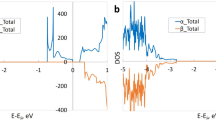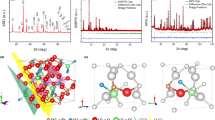Abstract
FRANCO and REGI's1 diffraction patterns and lattice images of anion-deficient strontium titanate, SrTiO3−x, show a sixfold superlattice along [111] and associated lattice images with irregular fringe spacings. The possibility of anion vacancy ordering was induced with reference to the systems (Ba,Sr) MnO3–x (ref. 2) and BaFeO3–x (ref. 3). These results contrasted with earlier data on SrTiO3–x (0⩽x⩽0.5) which indicated4,5 on the basis of powder X-ray diffraction, a simple cubic cell with virtually unchanging lattice constant over the whole range of x. Here we draw attention to two points concerning the nonstoichiometry of strontium titanate. First, unlike the manganate and ferrate of refs 2 and 3, SrTiO3 is a simple cubic perovskite with cubic stacking of SrO3 layers. Second, in contrast to the impression given, oxygen vacancy ordering had not been convincingly established at all until recently in any anion-deficient cubic-stacked perovskite. Examples of such nonstoichiometric systems are SrTiO2.5–3.0 (refs 4, 5), SrVO2.5–3.0 (ref. 4), SrFeO2.78–3.0 (ref. 6) and Sr2LiMoO5.5 (ref. 7). I started to study the three strontium-transition metal oxide systems in the expectation that application of the more powerful diffraction techniques such as electron diffraction would reveal anion ordering processes possibly overlooked by X rays. This proved to be the case for the SrFeO3–x system where an ordered phase, SrFeO2.75, with superlattice reflections clearly apparent by electron diffraction, but not by powder X-ray diffraction, was found8.
This is a preview of subscription content, access via your institution
Access options
Subscribe to this journal
Receive 51 print issues and online access
$199.00 per year
only $3.90 per issue
Buy this article
- Purchase on Springer Link
- Instant access to full article PDF
Prices may be subject to local taxes which are calculated during checkout
Similar content being viewed by others
References
Franco, M. A. Alario & Regi, M. V. Nature 270, 706–707 (1977).
Jacobson, A. J. & Horrox, A. J. W. Acta crystallogr. B32, 1003–1008 (1976).
Jacobson, A. J. Acta crystallogr. B32, 1087–1090 (1976).
Kestigian, M., Dickinson, J. G. & Ward, R. J. Am. chem. Soc. 79, 5598–5601 (1957).
McCarthy, G. J., White, W. B. & Roy, R. J. Am. ceram. Soc. 52, 463–467 (1969).
MacChesney, J. B., Sherwood, R. C. & Potter, J. F. J. chem. Phys. 43, 1907–1913 (1965).
Sabatier, R., Wathlé, M., Besse, J. P. & Baud, G. J. inorg. nucl. Chem. 33, 1597–1613 (1971).
Tofield, B. C., Greaves, C. & Fender, B. E. F. Mat. Res. Bull. 10, 737–746 (1975).
Tofield, B. C., Crane, G. R., Bridenbaugh, P. M. & Sherwood, R. C. Nature 253, 722–723 (1975).
Chamberland, B. L. & Danielson, P. S. J. Solid St. Chem. 3, 243–247 (1971).
Dougier, P., Fan, J. C. C. & Goodenough, J. B. J. Solid St. Chem. 14, 247–259 (1975).
Author information
Authors and Affiliations
Rights and permissions
About this article
Cite this article
TOFIELD, B. Anion deficiency in strontium titanate. Nature 272, 713–714 (1978). https://doi.org/10.1038/272713a0
Received:
Accepted:
Issue Date:
DOI: https://doi.org/10.1038/272713a0
Comments
By submitting a comment you agree to abide by our Terms and Community Guidelines. If you find something abusive or that does not comply with our terms or guidelines please flag it as inappropriate.



